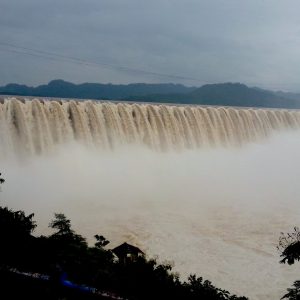Federal Water Tap, December 26: EPA, As Planned, Decreases Pollution Inspections
The Rundown
The EPA inspects fewer facilities to focus on big-money enforcement cases. The EPA also lists 29 unregulated drinking water contaminants that certain utilities will monitor, to understand how frequently they are found in water systems. The Interior Department finalizes a rule to defend streams from coal mining damage. The head of the EPA says clean drinking water will be a top challenge for the next administration. The House Oversight Committee recommends curious federal responses to Flint. California almond growers will pay higher assessments to fund, among other things, water-saving research. Hurricane Matthew broke more than two dozen streamflow records in the Carolinas. The Obama administration publishes a climate science review and a report on soil science research priorities. And lastly, congressional researchers estimate that Obama administration rules issued after June 13, 2016, will be subject to repeal by the Trump administration.
“One of the areas, I think, is an area the next administration is going to have to make some big progress on: clean drinking water. There have been lots of lessons learned about how vulnerable some communities are.” — Gina McCarthy, head of the U.S. Environmental Protection Agency, speaking with the Washington Post about challenges ahead for the agency.
By the Numbers
June 13, 2016: Estimated date for determining which Obama administration rules can be overturned by the incoming administration. Rules finalized after that date are subject to the Congressional Review Act, a mechanism that allows a new Congress and president to strike down “midnight” rules issued in the final months by their predecessors. Passed in 1996, the CRA has been used successfully only once. The reason: the act requires control of the House, Senate, and the presidency during a changeover, to avoid vetoes. (Congressional Research Service)
29: Unregulated drinking water contaminants that will be monitored by a select group of water systems. The data will inform future decisions about whether the chemicals ought to be regulated. (U.S. Environmental Protection Agency)
26: Stream gauges in North Carolina and South Carolina that recorded a new peak flow during Hurricane Matthew in October. (U.S. Geological Survey)
$US 225 million: Funding for 88 drought resilience, water quality, wildlife habitat, and farm conservation projects. The funding is through a program established by the 2014 farm bill. (U.S. Department of Agriculture)
News Briefs
CAFO Inspections and Enforcement Continue to Slide
Federal inspections of cattle and hog feedlots, turkey houses, and other animal feeding operations dropped for a fourth consecutive year, according to U.S. Environmental Protection Agency data. The number of fines and orders to change management practices for those same facilities fell for a fifth consecutive year.The decline occurred even though EPA regulators in 2011 designated water pollution from concentrated animal feeding operations, or CAFOs, as a national enforcement priority. The priority list — including urban sewers and air emissions from chemical factories, refineries, power plants, and oil and gas development — targets serious and chronic violations of pollution laws in areas that are “particularly complex and challenging.”
For details on why this retreat should not surprise, see Circle of Blue’s full report.
House Oversight Releases Flint Findings
Rep. Jason Chaffetz (R-UT), committee chair, sent letters to House colleagues on the Appropriations, and Energy and Commerce committees with recommendations for responding to the Flint scandal.Chaffetz suggests that funds the White House requested to address climate change be redirected to upgrading U.S. water and sewer systems. He asked the Appropriations Committee, which controls the budget, “to review those requests to determine if they are consistent with the country’s most urgent needs.”
Chaffetz asked the Energy and Commerce Committee whether ambiguities in Safe Drinking Water Act caused EPA delay. The EPA Office of Inspector General, however, already addressed this matter. In an October 2016 report, the OIG found that the agency had the authority and information to act in Flint seven months earlier than it did so. Officials nonetheless hesitated. The OIG recommended that the agency update its enforcement guidelines and train staff to recognize when intervention is necessary and permitted.
Stream Protection Rule Finalized
The Interior Department finalized its Stream Protection Rule, which is designed to prevent damage from coal mining. The rule also guides the restoration of mined sites.The rule does not ban mining within 100 feet of streams, as some green groups desired, but it places a burden of proof on mining companies before they are allowed to do so. Companies must prove that no water quality standards will be violated and that they can restore the stream to its original function.
Remember, however, that all agency final rules issued after June 13 are subject to review and cancellation by the next Congress. Rep. Rob Bishop (R-UT), chairman of the House Natural Resources Committee, said that he wants to work with the Trump administration to overturn the rule.
Gina McCarthy Exit Interview
The EPA chief spoke with the Washington Post about her three-plus years as the nation’s top environmental regulator.McCarthy said that the next administration must focus on clean drinking water: “There have been lots of lessons learned about how vulnerable some communities are.”
McCarthy also acknowledged that the agency has a troubled relationship with rural communities that is primarily reflected in struggles over pollution rules that affect farms.
“We have tended to not be able to have a very compelling rural agenda and to build constituencies there,” she asserted. “That’s been challenging for us. Because we do know that runoff from agriculture and storm water — all these small sources of nutrients that are getting in our waters and streams — are the biggest challenge we face right now.”
Studies and Reports
Climate Science Overview
The Obama administration released a draft climate science review that will be the foundation of the fourth National Climate Assessment, a document ordered by Congress and due in 2018.Public comments on the draft report are being accepted through February 3 via an online system. Access the report via that link too.
It’s Not ‘Just Dirt’
The National Science and Technology Council, a White House body, released a report on federal priorities for soil science research. “It’s not just dirt,” the report states. Soil is a vital link between farm productivity and water use, and healthy soil helps filter and regulate water flows for downstream communities.The report identifies three broad threats to soil health: land-use changes such as conversion of farmland to suburban housing; unsustainable land management practices such as using too much fertilizer or lack of cover crops; climate change.
Stream Health
The EPA and the U.S. Geological Survey released a technical report on how to set stream flow standards that provide enough water for fish, insects, frogs, and other aquatic species. The report includes the science of stream flow, examples from states, and guidelines for flow standards.Cover Crops More Widespread in the East
When farm fields are denuded, sediments wash into rivers along with nitrogen in the soil. Cover crops are a solution, but adoption of the conservation practice is unevenly distributed in the United States, according to a USDA report. The Chesapeake Bay watershed, and Maryland in particular, is a leader because of state and federal policies that incentivize cover crops.On the Radar
Lead and Copper Rule Timetable
The EPA plans to issue a draft rule by June 2017 and a final rule by December 2018. Yes, that is still a rather long time from now. The current rule dates largely to 1991.Almond Assessments Go Up
The Almond Board of California, established by congressional order, is increasing its levy on growers, from three cents per pound to four cents. The rate will return to three cents per pound in August 2019.The board says it needs more money for research, namely for water use and bee health, which are essential for the almond industry’s future. The board positions its research as useful in countering media narratives during California’s drought about the water profligacy of almonds:
“Through the research programs funded by the board, the marketing team was able to provide data regarding almonds and water use. This research was pivotal in transitioning the conversation from negative to neutral or positive.”
Federal Water Tap is a weekly digest spotting trends in U.S. government water policy. To get more water news, follow Circle of Blue on Twitter and sign up for our newsletter.
Brett writes about agriculture, energy, infrastructure, and the politics and economics of water in the United States. He also writes the Federal Water Tap, Circle of Blue’s weekly digest of U.S. government water news. He is the winner of two Society of Environmental Journalists reporting awards, one of the top honors in American environmental journalism: first place for explanatory reporting for a series on septic system pollution in the United States(2016) and third place for beat reporting in a small market (2014). He received the Sierra Club’s Distinguished Service Award in 2018. Brett lives in Seattle, where he hikes the mountains and bakes pies. Contact Brett Walton





